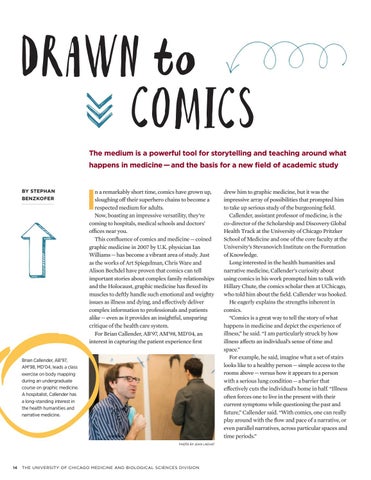The medium is a powerful tool for storytelling and teaching around what happens in medicine — and the basis for a new field of academic study
BY STEPHAN BENZKOFER
I
n a remarkably short time, comics have grown up, sloughing off their superhero chains to become a respected medium for adults. Now, boasting an impressive versatility, they’re coming to hospitals, medical schools and doctors’ offices near you. This confluence of comics and medicine — coined graphic medicine in 2007 by U.K. physician Ian Williams — has become a vibrant area of study. Just as the works of Art Spiegelman, Chris Ware and Alison Bechdel have proven that comics can tell important stories about complex family relationships and the Holocaust, graphic medicine has flexed its muscles to deftly handle such emotional and weighty issues as illness and dying, and effectively deliver complex information to professionals and patients alike — even as it provides an insightful, unsparing critique of the health care system. For Brian Callender, AB’97, AM’98, MD’04, an interest in capturing the patient experience first
Brian Callender, AB’97, AM’98, MD’04, leads a class exercise on body mapping during an undergraduate course on graphic medicine. A hospitalist, Callender has a long-standing interest in the health humanities and narrative medicine.
PHOTO BY JEAN LACHAT
14
THE UNIVERSITY OF CHICAGO MEDICINE AND BIOLOGICAL SCIENCES DIVISION
drew him to graphic medicine, but it was the impressive array of possibilities that prompted him to take up serious study of the burgeoning field. Callender, assistant professor of medicine, is the co-director of the Scholarship and Discovery Global Health Track at the University of Chicago Pritzker School of Medicine and one of the core faculty at the University’s Stevanovich Institute on the Formation of Knowledge. Long interested in the health humanities and narrative medicine, Callender’s curiosity about using comics in his work prompted him to talk with Hillary Chute, the comics scholar then at UChicago, who told him about the field. Callender was hooked. He eagerly explains the strengths inherent in comics. “Comics is a great way to tell the story of what happens in medicine and depict the experience of illness,” he said. “I am particularly struck by how illness affects an individual’s sense of time and space.” For example, he said, imagine what a set of stairs looks like to a healthy person — simple access to the rooms above — versus how it appears to a person with a serious lung condition — a barrier that effectively cuts the individual’s home in half. “Illness often forces one to live in the present with their current symptoms while questioning the past and future,” Callender said. “With comics, one can really play around with the flow and pace of a narrative, or even parallel narratives, across particular spaces and time periods.”
